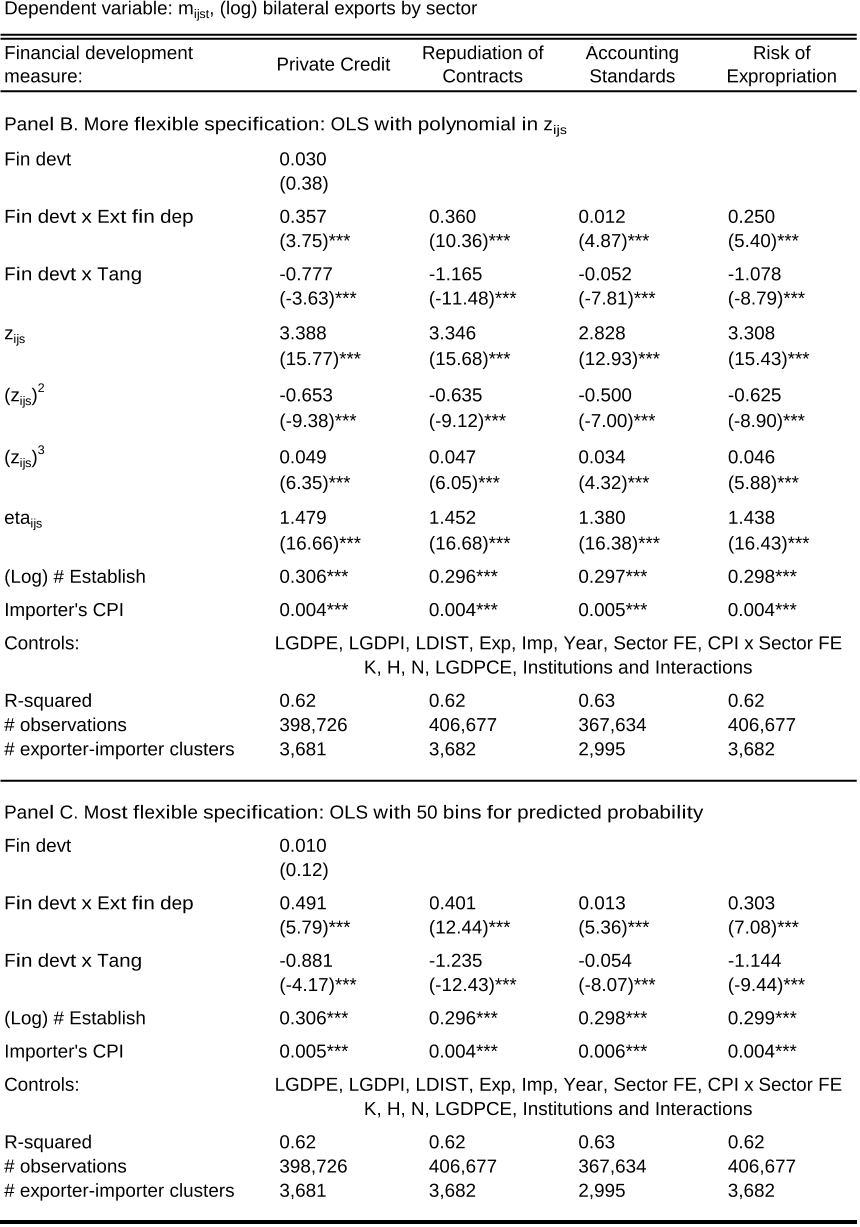Credit Constraints, Heterogeneous Firms and International Trade
Reads0
Chats0
TLDR
This article examined the detrimental consequences of financial market imperfections for international trade and developed a heterogeneous-firm model with countries at different levels of financial development and sectors of varying financial vulnerability.Abstract:
This paper examines the detrimental consequences of financial market imperfections for international trade. I develop a heterogeneous-firm model with countries at different levels of financial development and sectors of varying financial vulnerability. Applying this model to aggregate trade data, I study the mechanisms through which credit constraints operate. First, financial development increases countries' exports above and beyond its impact on overall production. Firm selection into exporting accounts for a third of the trade-specific effect, while two thirds are due to reductions in firm-level exports. Second, financially advanced economies export a wider range of products and their exports experience less product turnover. Finally, while all countries service large destinations, exporters with superior financial institutions have more trading partners and also enter smaller markets. All of these effects are magnified in financially vulnerable sectors. These results have important policy implications for less developed economies that rely on exports for economic growth but suffer from poor financial contractibility.read more
Figures

Table 10. Economic Significance: Predicted vs. Actual Trade Growth 
Table 9. Economic Significance: Comparative Statics 
Table 5. Financial Development and Firm-Level Exports 
Figure 3. The Productivity Cut-off for Exporting 
Table 5. Financial Development and Firm-Level Exports 
Table 1. Export Patterns in the Data
Citations
More filters
Journal ArticleDOI
Exporting under financial constraints: margins, switching dynamics and prices
TL;DR: This paper showed that constrained firms have a reduced probability of adding and a higher probability of dropping products and destinations, while unconstrained firms sell their products at higher prices as compared to constrained firms, and the results are robust to specific control for unobserved heterogeneity, self-selection into export and potential endogeneity of the financial constraints proxy.
Dissertation
Cantillon effects in international trade : the consequences of fiat money for trade, finance, and the international distribution of wealth
TL;DR: In this paper, the authors analyze the impact of monetary expansion on prices, production, wealth, and the pattern of international trade and conclude that monetary expansion modifies the direction, composition, volume and value of trade and capital flows.
Journal ArticleDOI
Financial development and the product cycle
TL;DR: This paper developed a model to study how financial institution differences across countries affect the offshoring decision of Northern firms and whether a product cycle arises when the only comparative advantage of Northern suppliers is their access to better financial institutions.
Journal ArticleDOI
Learning via sequential market entry: Evidence from international releases of U.S. movies
TL;DR: The authors found that a one standard deviation increase in the expected box-office revenues from the previous round is associated with an increase in probability of entry to a given market of approximately 20% and this effect is robust to other potential determinants of entry, including extended gravity, seasonality of demand, academy award nominations, and competition from local and imported pictures.
Posted Content
Financial Factors and Manufacturing Exports: Firm-Level Evidence From Egypt
TL;DR: In this paper, the authors focus on the effects of financial factors on manufacturing firms' export participation in a panel of Egyptian manufacturing firms over the 2003-2008 period and show that financial constraints reduce export participation of Egyptian firms, while financial liquidity improves it.
References
More filters
Posted Content
Law and Finance
Rafael La Porta,Rafael La Porta,Florencio Lopez de Silanes,Florencio Lopez de Silanes,Andrei Shleifer,Andrei Shleifer,Robert W. Vishny,Robert W. Vishny +7 more
TL;DR: This paper examined legal rules covering protection of corporate shareholders and creditors, the origin of these rules, and the quality of their enforcement in 49 countries and found that common law countries generally have the best, and French civil law countries the worst, legal protections of investors.
Journal ArticleDOI
Law and Finance
TL;DR: In this article, the authors examined legal rules covering protection of corporate shareholders and creditors, the origin of these rules, and the quality of their enforcement in 49 countries and found that common-law countries generally have the strongest, and French civil law countries the weakest, legal protections of investors, with German- and Scandinavian-civil law countries located in the middle.
Journal ArticleDOI
The Impact of Trade on Intra-Industry Reallocations and Aggregate Industry Productivity
TL;DR: This paper developed a dynamic industry model with heterogeneous firms to analyze the intra-industry effects of international trade and showed how the exposure to trade will induce only the more productive firms to enter the export market (while some less productive firms continue to produce only for the domestic market).
Journal ArticleDOI
Finance and Growth: Schumpeter Might Be Right
TL;DR: In this paper, the authors examined a cross-section of about 80 countries for the period 1960-89 and found that various measures of financial development are strongly associated with both current and later rates of economic growth.
ReportDOI
Financial Dependence and Growth
Raghuram G. Rajan,Raghuram G. Rajan,Raghuram G. Rajan,Luigi Zingales,Luigi Zingales,Luigi Zingales +5 more
TL;DR: This paper examined whether financial development facilitates economic growth by scrutinizing one rationale for such a relationship; that financial development reduces the costs of external finance to firms, and found that industrial sectors that are relatively more in need of foreign finance develop disproportionately faster in countries with more developed financial markets.